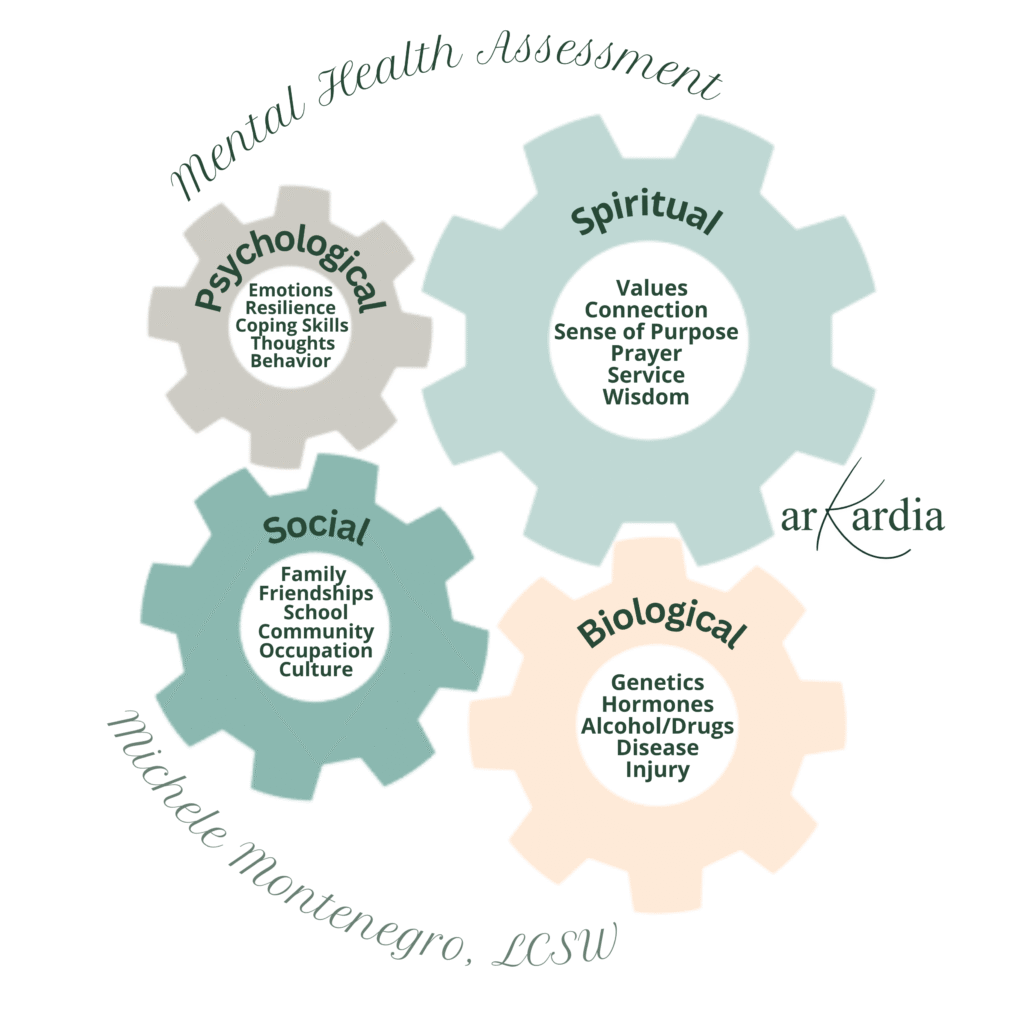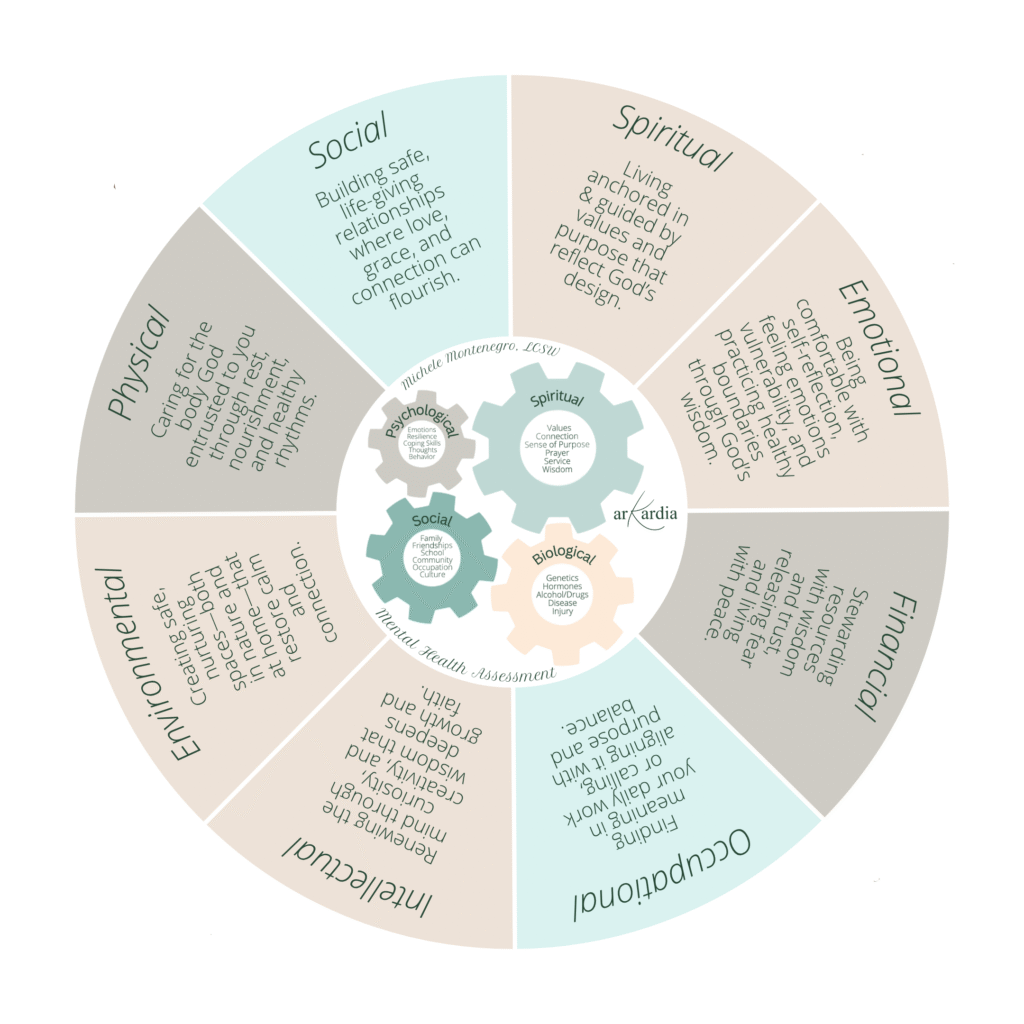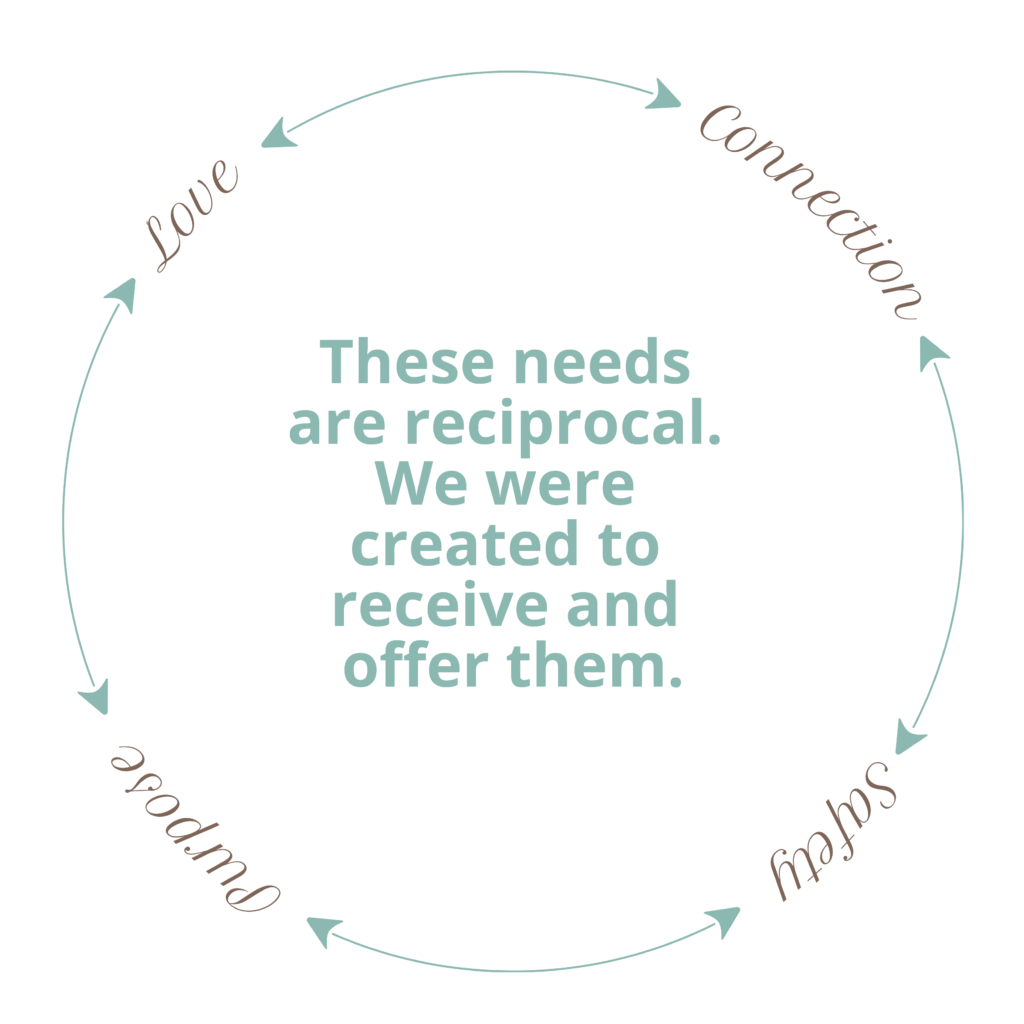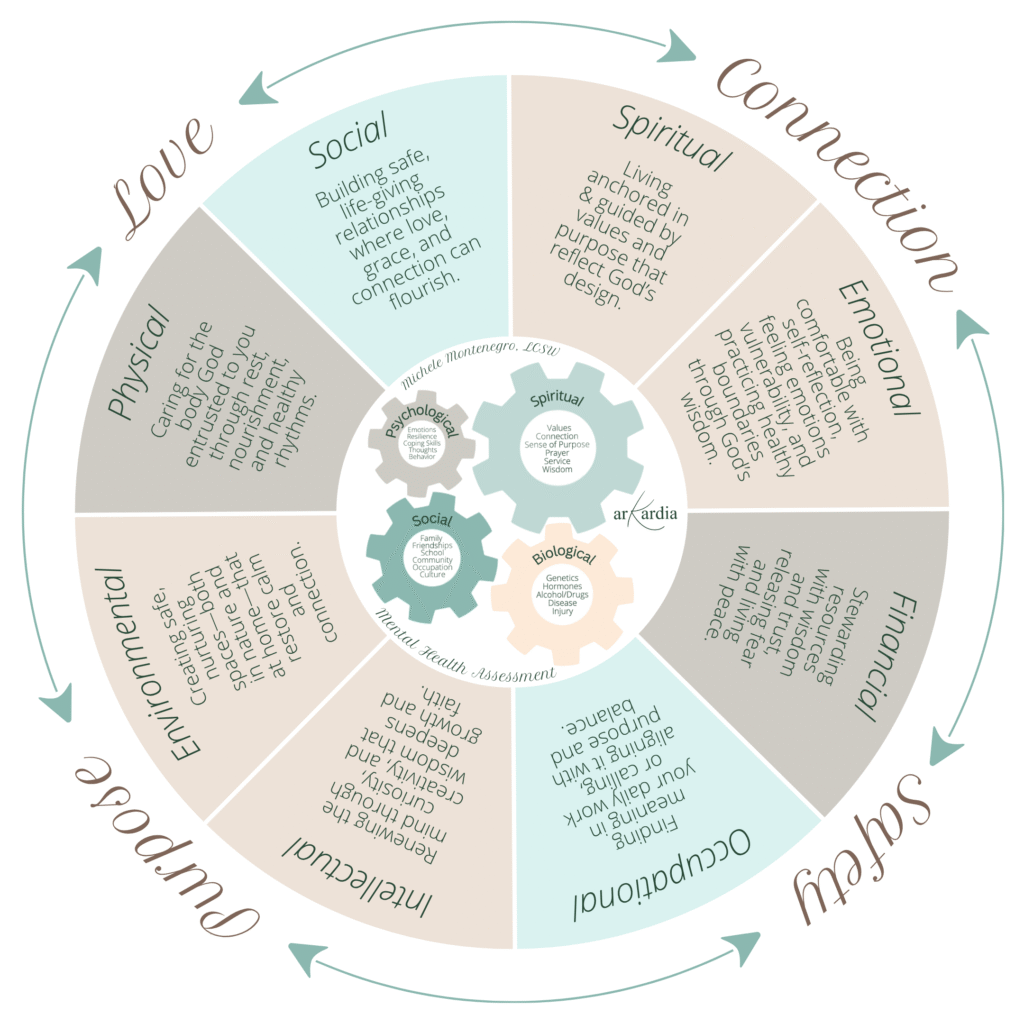Kardia Wellness Wheel: 3 Essential Layers for Wholeness, Balance, and Lasting Freedom
Introduction: Why Wholeness Matters
Have you ever felt like no matter how hard you try to fix one part of your life, another part begins to unravel? You work on your  health, but stress shows up in your sleep. You pour energy into your relationships, but anxiety lingers beneath the surface. Or maybe you push through the pain, telling yourself to “just keep going,” only to find that the weight keeps resurfacing in new ways.
health, but stress shows up in your sleep. You pour energy into your relationships, but anxiety lingers beneath the surface. Or maybe you push through the pain, telling yourself to “just keep going,” only to find that the weight keeps resurfacing in new ways.
That’s because our struggles don’t exist in isolation. Every part of who we are is deeply connected. Stress in the body affects emotions. Relationship strain can drain our sense of safety or purpose. And when faith feels distant, even the simplest routines can feel heavier.
Every part of who we are is deeply connected.
The truth is, healing doesn’t happen by addressing one piece at a time. Wholeness comes when we step back and see the bigger picture—mind, body, spirit, relationships, and even the environments we live in.
The Kardia Wellness Wheel, developed at arKardia Counseling & Consulting, is a multidimensional model of wholeness. It shows how different parts of life interact, how pain in one area ripples into others, and how healing in that same area can bring restoration across the whole system.
Layer 1: Biopsychosocial Core in the Kardia Wellness Wheel
At the center of the Kardia Wellness Wheel is a biopsychosocial assessment, which is created from a faith-integrated therapy lens. This “mental health” assessment is a comprehensive exploration of four interconnected areas: spiritual, psychological, biological, and social. These are the “cogs” at the center of the model, and together they form the engine that drives our well-being.
The idea of addressing biological, psychological, and social factors together began with Engel’s biopsychosocial model (Engel, 1977), which continues to influence holistic approaches to health today.
Healing begins at the root—partnering with God’s design for wholeness.
You will notice that the spiritual cog is the largest. This is intentional. Faith anchors and sustains every part of the system. When faith is active and alive, it builds resilience. And when one of the other cogs is strained, faith can help keep the system moving until balance is restored.

Our lived experiences, represent the details in the cogs. I often describe it like this: our lives are a story written in a book, but sometimes that book is so close to our face we can’t make out the words. My role is to gently pull the book back so the pages can be read more clearly. The biopsychosocial assessment provides that perspective, helping us see how past experiences, current stressors, and inner strengths are woven into our larger story.
This assessment is the starting point. From here, I work with clients to create a map for healing. Together, we identify the areas that need care, set goals that align with values and faith, and choose approaches most likely to bring lasting change. Instead of just managing symptoms, the goal is to restore wholeness—so each person can move toward greater freedom, peace, and joy.
Layer 2: The Eight Dimensions of Wellness Through a Faith-Integrated Lens
Surrounding the four cogs at the core are the broader dimensions of wellness—where our daily lives are lived out. This layer of the Kardia Wellness Wheel is based on the eight dimensions of wellness. The concept of a wellness wheel originated with Dr. Bill Hettler, who introduced six dimensions of wellness in 1976 (Hettler, 1976). Later, Dr. Peggy Swarbrick expanded the model to include eight dimensions, which are now widely applied in wellness and mental health frameworks (Swarbrick, 1997). Their work provides a foundation. I integrate these dimensions through a faith-centered lens, recognizing that God created us as whole beings where every part influences the other.
Here’s how they look through a faith-integrated lens:
-
Spiritual: Living anchored in God’s truth, guided by values and purpose.
-
Emotional: Embracing self-reflection, vulnerability, and healthy boundaries with God’s wisdom.
-
Physical: Caring for the body God entrusted through rest, nourishment, and healthy rhythms.
-
Social: Building safe, life-giving relationships where love and connection can flourish.
-
Occupational: Finding meaning in daily work or calling, aligned with purpose and balance.
-
Financial: Stewarding resources with wisdom and trust, releasing fear and finding peace.
-
Environmental: Creating safe, nurturing spaces that restore calm and connection with God’s creation.
-
Intellectual: Renewing the mind through curiosity, creativity, and wisdom rooted in faith.

These are like the outer ring of our story, where what happens inside begins to ripple outward.
Growth in one area strengthens the others; struggle in one creates stress across the system.
In therapy, I see these connections all the time. A prolonged season of stress may spill into financial strain or lead to burnout at work. Unresolved trauma can surface as physical pain or health concerns. Even wounds from a “good family” may emerge as strained relationships or emotional instability. Pain isn’t always loud or obvious. Sometimes it’s the quieter unmet needs that echo into adulthood.
At the same time, healing in one area creates ripples across the others. Strengthening spiritual practices can build emotional resilience. Restoring rhythms in the body can spark clarity and confidence at work. God designed us to be whole and connected, which means growth in one dimension is never wasted because it contributes to restoration across the system.
Even small steps of healing can begin to bring balance and renewal across life’s dimensions.
Layer 3: Four Essential Needs – Love, Connection, Safety, and Purpose
At the outer layer of the Kardia Wellness Wheel are the four essential human needs: love, connection, safety, and purpose. These needs are supported by decades of research in human motivation and attachment theory. Maslow’s hierarchy of needs highlights safety, love, and belonging as foundational to well-being (Maslow, 1943), while Bowlby’s attachment theory shows how secure connections are vital for healthy human development (Bowlby, 1988).
These are not just another layer of the model. They are the environment God designed us to live in. They surround and sustain everything else, creating the conditions for wholeness to take root.
Love, connection, safety, and purpose are the environment God designed us to live in.
These needs act like oil that allows the cogs at the core to move smoothly and in unison. When they are nurtured, the system can function with balance and strength. But when they are threatened, the cogs can slow, creating ripples of strain across the multidimensional model.
For example, safety can be compromised not only by external harm and basic needs like air, food, water and shelter, but also by something as wearing as a chronic or life-threatening illness (biological). Connection may falter when a diagnosis or personal struggle, such as betrayal, makes it difficult to relate to others, leaving someone feeling isolated even in the midst of community (social). Love can feel fractured when early attachment wounds left needs unspoken or unmet, later surfacing as feelings of not being good enough or difficulty showing compassion to oneself (psychological). And purpose may grow dim in seasons of loss, transition, or disappointment, making it harder to recognize God’s hand in the story (spiritual).

These needs also work in two directions: we are designed not only to receive love, connection, safety, and purpose, but also to offer them. Healing deepens when we allow God and others to meet these needs in us, while also becoming channels of love, connection, safety, and purpose in the lives of others.
When these four needs are tended to, the cogs move with greater ease. Even if one slows under the weight of a present stressor or event, the wellness wheel can regain balance, and the story of our life begins to unfold with more clarity. Wholeness is not only about balance—it is about living as we were created to: securely in God’s love, meaningfully connected, safely held, and guided by His purpose.
When these four needs are tended to, the wellness wheel regains balance.
This truth becomes especially evident when people describe a deepening relationship with God. In those moments, it’s not just an idea—they feel His presence, experience His love, and recognize at the core of their being that they are not forgotten, not broken beyond repair, but truly worthy. That sense of worthiness, rooted in God’s love, is what allows the rest of the wheel to move with strength and freedom.
Why Wholeness Matters for Healing
Healing isn’t about quick fixes or patching over one part of life. It’s about finding peace in the whole-person journey.Because everything is connected, what feels heavy in one area will inevitably touch the others. The hope-filled truth is that even small steps toward healing create ripples of renewal across your whole life.
Even the smallest steps of healing can create ripples of renewal across your whole life.
The Kardia Wellness Wheel makes this visible: every part of us matters and every part is connected. And when love, connection, safety, and purpose are nurtured, we begin to flourish in the way we were created to—secure in God’s love, meaningfully connected, and guided by His purpose.
Take a moment to reflect:
-
Which part of your own wellness wheel feels most alive right now?
-
Which part feels like it needs more care?
-
Where might God be gently inviting you to pause, restore, and heal?

And remember—you don’t have to walk this path alone. Whether through faith-integrated therapy, a focused intensive, or the shared strength of a healing retreat, there are safe, supportive spaces to help you reconnect, restore balance, and move toward greater freedom, peace, and joy.
Every part matters. Every part is connected.
References
-
Bowlby, J. (1988). A secure base: Parent-child attachment and healthy human development. Basic Books.
-
Engel, G. L. (1977). The need for a new medical model: A challenge for biomedicine. Science, 196(4286), 129–136.
-
Hettler, B. (1976). The six dimensions of wellness model. National Wellness Institute.
-
Maslow, A. H. (1943). A theory of human motivation. Psychological Review, 50(4), 370–396.
-
Swarbrick, M. (1997). A wellness model for clients. Mental Health Special Interest Section Quarterly, 20(1), 1–4.
 by: Michele Montenegro, MSW, LCSW
by: Michele Montenegro, MSW, LCSW
